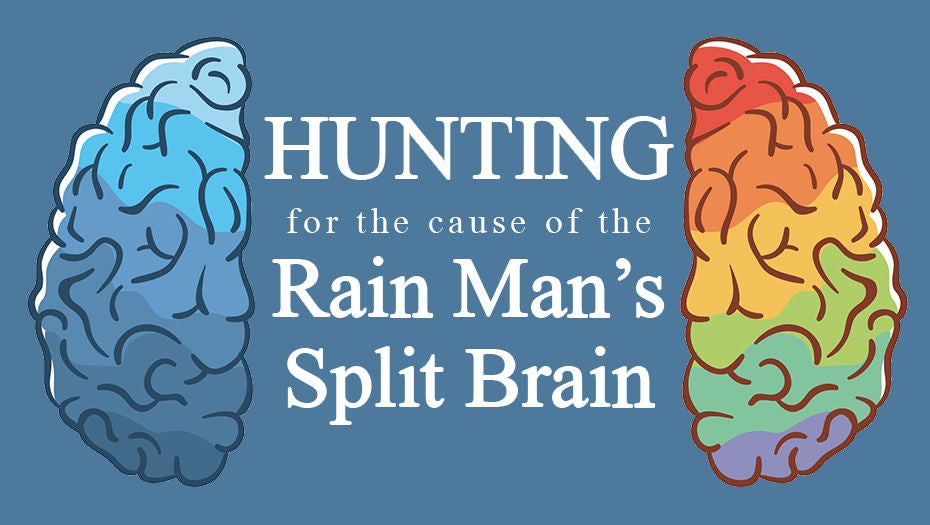
Photo: Freepik.
In the movie Rain Man, the lead character played by Dustin Hoffman was based on a real person, who was portrayed as a savant. Although, limited in his abilities to interact socially, he had phenomenal memory and recall, which were attributed to his “split brain”. Now, decades later, the cause for split brain has been found … by a SingHealth researcher
Mr Laurence Kim Peek, could not button his shirt or operate a light switch, but could, reportedly, recall the contents of 12,000 books. His vast memory was compared to that of a computer.
Born in 1951, he was thought to be autistic. However, today’s research reveals that he had a rare genetic disorder called developmental split brain syndrome (DSBS), where the right and left sides of the brain do not talk to each other. That was why, as a renowned mega savant, he could not do simple things, but was adept at extraordinary feats of memory.
Mr Peek, who inspired Hoffmann’s character in Rain Man, died at age 58. He was widely studied, but there has not been a precise explanation of his abilities and disabilities for five decades.
A SingHealth global discovery
Pinning down the genetic condition of DSBS was the work of Dr Saumya Jamuar, Senior Consultant, Genetics Service, KK Women’s and Children’s Hospital (KKH).
Under the supervision of Prof Christopher Walsh and A/Prof Timothy Yu at Harvard, Dr Saumya led a study on this condition. He recently published a paper “Biallelic mutations in Human DCC cause development split-brain syndrome” in Nature Genetics, which was selected for the American Society of Human Genetics Trainee Spotlight award.
The finding, a huge step forward, has wider implications for commoner diseases such as autism, Asperger syndrome, squint and scoliosis.

Dr Saumya at work in his lab in Singapore. His breakthough came after he found three families from different parts of the world with similar features of developmental split brain syndrome. Photo: KK Women’s and Children’s Hospital.
When the two sides don’t converse
Developmental split brain syndrome occurs when a child is born with missing connections between the left and right sides of the brain. Those affected cannot look sideways, they have mirror movements (e.g. when the right hand goes up, the left hand goes up too) and scoliosis (curved spine).
In a developing fetus, the neurons move across the midline to connect the two sides of the brain. The bulk of this happens through an organ called corpus callosum, which can be compared to a bridge. Each neuron going through this “bridge”, has to have sensors (called DCC receptors), which guide it in the correct direction. Patients with DSBS are missing these sensors. Hence, the neurons cannot cross the bridge, and instead, stay on the same side. This leads to the split brain phenomenon.
Eureka!
There are less than 15 cases scattered globally. His breakthrough came when he found the first three families – from Texas, the Middle East and the Harvard database – with features of DSBS.
He said the discovery is just the tip of the iceberg. “There’s still a lot to learn, both for DSBS as well as in human genetics. There are 20,000 genes and we only know 7,700 of them. But this work has given us the mechanism to study other families with rare or novel genetic conditions. If we can start answering why these patients have the disease, we can look towards building tools to cure them.”
Next – gene editing?
In the past four years, KKH set up the Singapore Undiagnosed Disease Programme in collaboration with A* STAR (Agency for Science, Technology and Research) and the National University Hospital. “So far we’ve studied 324 families and diagnosed 125 of them. In addition, we have identified four new genetic disorders” said Dr Saumya.
Dr Saumya said, in the field of genomics, people are talking about curing genetic diseases with gene editing.
“Once we have the genetic diagnosis we can attempt to edit it back to normal. But gene editing is in its infancy and caution is needed lest it goes down a slippery slope of designer babies. However, it is safe to say that one day, for medical indications, it may be possible to edit the gene to cure the disease. And that possibility is exciting, not just for me, but also for my patients.”













 Get it on Google Play
Get it on Google Play